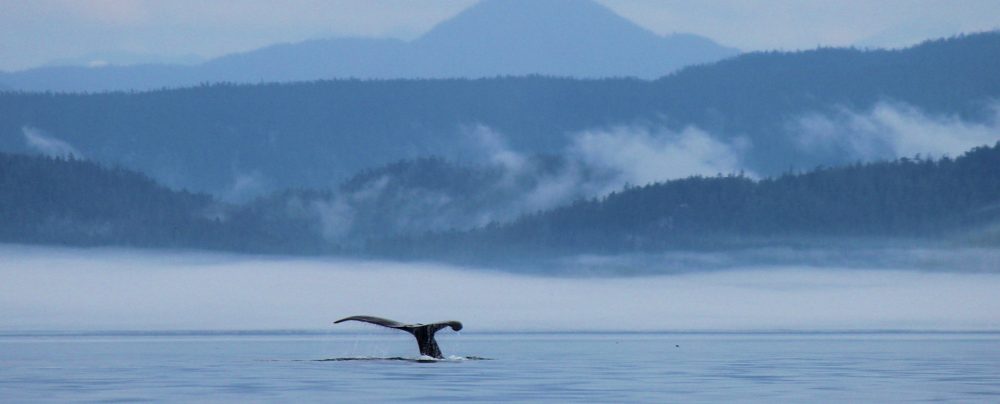The humpback whale (Megaptera novaeangliae) was given its common name because of the shape of its dorsal fin and its unique diving behaviour. Its scientific name, Megaptera, means “large-winged” and refers to its long, white, wing-like flippers. These fins can be as big as one-third of the animal’s body length and give incredible maneuverability, even being used to swim backwards and hang upside down!
Found throughout the world’s oceans, there are three distinct populations of humpbacks: one in the North Pacific, one in the North Atlantic, and another in the Southern Hemisphere. Northern Hemisphere humpbacks reach an average length of 49 to 52 feet (15-16 m). The average weight for a mature adult is 35 to 50 tons, with females generally being larger than males. Humpbacks are primarily dark grey or black in colour, with a variable amount of white on their pectoral fins, belly and fluke. This variation is so distinctive that patterns on the undersides of their flukes can be used to identify individual whales, similar to a human fingerprint.
Humpback whales make a seasonal migration, one of the farthest of any mammal. Summers are spent feeding in cold, productive coastal waters; and winters in warmer, shallower waters more suitable for breeding and calving. One of the more closely studied routes is between Alaska and Hawaii, where humpbacks have been observed making the 3,000 mile (4,830 km) trip in as few as 36 days.
Humpback whales are a favourite of whale watchers; they are incredibly acrobatic, performing aerial displays, such as breaching or slapping the surface with their pectoral fins or tails; believed to be a form of communication. Humpbacks are baleen whales, using baleen plates to strain small fish such as krill or herring and plankton out of the water. They can consume up to 3,000 pounds (1,360 kg) of food per day and use several different feeding methods including ‘lunge feeding’ and ‘bubble net feeding’. Humpbacks are best known for their ‘singing’ behaviour, thought to be only performed by males, lasting as long as 20 minutes, and serving a role in dominance, aggression and mate attraction.
Like other large whales, the humpback was a target for the whaling industry and their population became severely depleted. About 21,000 humpbacks were recorded caught in the North Pacific until they were protected by a moratorium in 1966 by the International Whaling Commission, with commercial whaling ending in British Columbia in 1968. Recent data indicates there are now over 2,100 humpbacks in BC and their numbers are increasing at a rate of about four per cent per year. This recovery is due to the cessation of whaling, but also the protection of winter breeding areas in Mexico and Hawaii, and their protection under the Canadian Fisheries Act.The pre-whaling population estimate for BC is about 4,000 whales in 1905 – almost twice the size of the current population. So while recovery is not yet complete, and threats such as entanglement in fishing gear, collisions with ships and noise pollution still exist, the future of humpbacks in BC looks very promising!
